Lara Dunston, The Guardian, October 28, 2014
Infrastructure in Cambodia is not as well developed as in neighbouring Thailand and Vietnam, and floods and poor roads make travel challenging during the monsoon season, from May to October, but cheap frequent bus services, a good domestic airline and easygoing locals make travelling here an adventure – and easier than you might think.
From Siem Reap
Start in Siem Reap by following our Angkor Wat holiday itinerary, which focuses on ‘Temple Town’, the springboard for exploring the Khmer empire’s world heritage archaeological sites, and the surrounding area.
You can get to Siem Reap by train or bus from Bangkok (allow a full day) or on a short flight from Bangkok, Singapore, Ho Chi Minh City and other Asian capitals. See our Top 10 hotels, hostels and B&Bs near Angkor Wat for places to stay.
Off-the-beaten-track temples
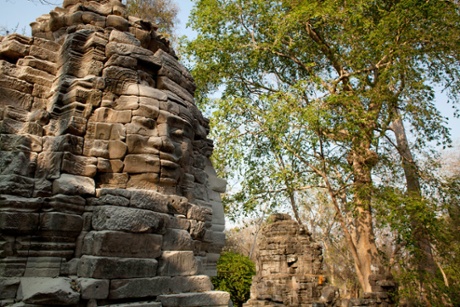
Banteay Chhmar, near Battambang. Photograph: Dennis Drenner/Alamy
If you’re not “templed out”, you could spend two days seeing these alluring yet little-visited temples.
Prasat Preah Vihear
Perched spectacularly on a plateau in the Dangrek mountains, Prasat Preah Vihear (£3 entry) is a sprawling, Unesco world heritage listed temple from the Angkor-era. It is 135 miles northeast from Siem Reap and straddles the Thai border. It’s just about doable on a day trip, however, an overnight stay at Preah Vihear Hotel (doubles from £49), 19 miles away, allows you to savour both sunset and sunrise at the site. Siem Reap-based Beyond Unique Escapes offers a tours from US$80 per person.
Banteay Chhmar
Remote Banteay Chhmar (£3 entry), 105 miles northwest of Siem Reap, is an enjoyable detour en route to Battambang. It’s worth the journey for its size – it’s the fourth largest Angkorian temple – unspoilt setting, and chance to experience a homestay with a local family in a traditional Khmer house ($7 per room; meals $1-$3). See the Banteay Chhmar Tourism website for details on getting there.
Battambang city and province
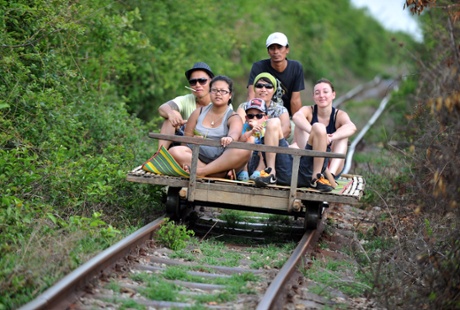
The ‘bamboo train’ ride at Battambang. Photograph: Geoff Moore/REX
Riverside Battambang is Cambodia’s second largest city although it feels like a country town. Most visitors are here to hurtle through the rice fields on the “bamboo ‘train”, known in Khmer as a norry (one hour, £3), a wooden frame covered with slats of bamboo and powered by a motorbike engine that runs on a single-track railway built by the French in the 1920s. They are fun, but it’s worth spending a couple of days taking in the city’s architecture and arts, sampling street food, cycling to villages, and doing tuk tuk tours into the countryside to see Angkorian temples and visit cottage industries.
Check into colonial-style Bambu Hotel (doubles from $90) in the centre or for a village experience try the Khmer wooden houses at Maisons Wat Kor (doubles from $94) in Wat Kor village.
Battambang’s protected heritage quarter is home to 800 significant buildings, including a 150-year old Chinese temple, charming shop-houses, elegant colonial French buildings, glittering pagodas and striking modernist buildings from the New Khmer Architecture movement. Battambang Bike offers architecture and art-themed cycle tours ($20) and village bike rides and also rents bicycles.
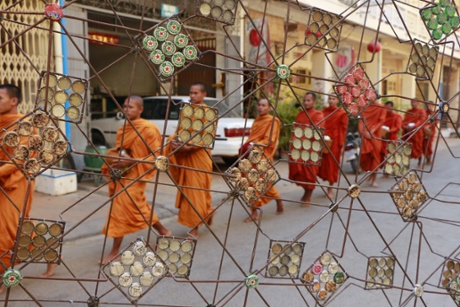
Monks outside the Maek Maek gallery, in front of sculpture by Battambang artist Mao Soviet. Photograph: Claire Knox/The Guardian
Thanks to the 20-year old Phare Ponleau Selpak performing arts and visual arts school, which has a circus department and big top (shows Monday and Thursday 7pm, one hour, $8), there’s a flourishing arts scene. Galleries and art spaces that can be browsed include Make Maek, Lotus Bar and Gallery and Sammaki on Street 2½, Studio Art Battambang on Street 1½, and BCi Battambang opposite the Royal Hotel.
Battambang is Cambodia’s rice bowl and boasts the country’s finest food. Visit Phsar Boeung Choeuk market to see fresh local produce. Try noodles and dumplings handmade to order at Lan Chov Khorko Miteanh (145 Street 2) or dine on pan-Asian cuisine at stylish Jaan Bai (Street 2), a social enterprise restaurant and bar that trains and employs disadvantaged kids, with a menu by Asia’s best chef, David Thompson of Nahm Bangkok. At sunset, stalls set up around Phsar Nath market to sell soups, curries and barbecue meats. Battambang Resort runs a fantastic snack tour (from $7) to sample street food at riverside stalls and eateries.
You can hire a tuk-tuk for around £9 a day, or £6 half a day, and take an excursion into the lush countryside to see artisanal producers make incense, cotton kramas (traditional Cambodian checked scarves), rice paper, noodles, and rice wine. En route visit Angkorian-era temples such as crowd-free Ek Phnom and Wat Banan, and Mount Sampeau, site of the Killing Caves, where the Khmer Rouge dumped its victims bodies; at dusk watch millions of bats emerge for a cave.
Asia-based Backyard Travel has a three-day Beyond Angkor: Battambang and its Countryside tour, taking in many of these experiences, which departs from Siem Reap and costs $469pp all-inclusive.
Phnom Penh
From Battambang, there are some 20 buses a day to Phnom Penh (six hours, longer during the monsoon, about £4). Use our Phnom Penh in three days holiday itinerary to make the most of your time in the cosmopolitan capital, and our Top 10 hotels, hostels and B&Bs in Phnom Penh for our recommendations for where to stay.
Rivers, forests and mountains
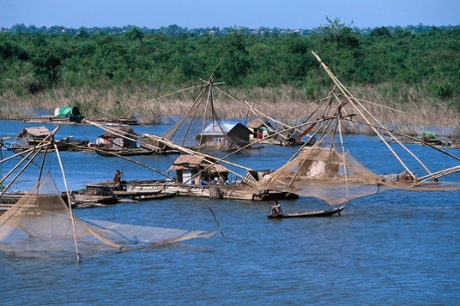
Traditional fishing methods at Kompong Cham on the Mekong river. Photograph: Look, die Bildagentur der Fotografen/Alamy
The cooler eastern provinces of Mondulkiri and Ratanakiri are home to lazy rivers, rubber plantations, rolling hills, forested mountains, impressive waterfalls and endangered wildlife.
Kompong Cham and Kratie
The provincial capital, Kompong Cham, is on the Mekong and 75 miles northeast of Phnom Penh, is an easy bus ride (2½ hours, around £3) from the capital. It makes for a relaxing stop for a riverside walk, a bike ride over a bamboo bridge to Koh Paen island, or a sunset cruise (£6).
Most travellers make a beeline for Kratie by bus (three hours from Kompong Cham, £3; five hours from Phnom Penh, £7), also located on the Mekong. Stay at friendly Le Tonlé Tourism Training Center (doubles from $10) in Kratie, which trains underprivileged youths, or a traditional Khmer timber house at Rajabori Villas (doubles from $60) on idyllic Koh Trong island, home to a Vietnamese floating village.
Rich in French colonial architecture, Kratie is a pleasant place to kick back. The main attraction, however, is the endangered freshwater Irrawaddy dolphins that can be seen 10 miles north of town. Take a moto (£3) or remork (£6), then a boat (£5).
Stung Treng and Ban Lung
Two and a half hours from Kratie by bus, Stung Treng is another laidback riverside town that makes a good base for seeing the Irrawaddy dolphins from the villages of O’Svay and Preah Rumkel, where wetlands are rich in birdlife.
A further two and half hours away by bus, Ban Lung is a base for various activities, including kayaking, mountain biking, trekking in Virachey national park to see some of Cambodia’s last remaining virgin forest, visits to ethnic minority villages, and swimming at Boeng Yeak Lom, a vivid blue crater lake.
You can walk through the forest with elephants at the Elephant Valley Project (full day $85, including transport and lunch), which adopts mistreated Asian elephants, or do an overnight trek to see wild, rare northern yellow-cheeked gibbons in the Veun Sai-Pang Conservation Area with from £$199 per person.
Set in luxuriant gardens, lakeside Terres Rouges Lodge (doubles from $58) is furnished with Cambodian antiques; while budget-friendly Treetop Ecolodge (doubles $12) has rustic bungalows and sweeping valley vistas. The Vietnam border is two hours by mini-bus from Ban Lung ,or it’s an 11-hour bus ride back to Phnom Penh.
Beaches and islands
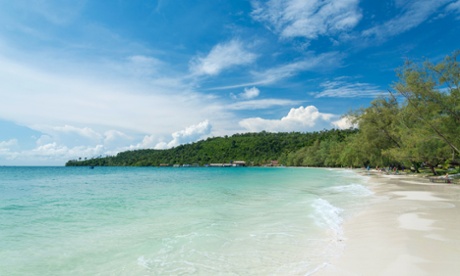
The island of Koh Rong, southern Cambodia. Photograph: Jack Malipan Travel Photography/Alamy
Cambodia’s sleepy south coast is skirted by pristine sandy beaches shaded by coconut palms and casuarinas, while off shore there are blissfully undeveloped islands. See our Top 10 beach hotels and bungalows in Cambodia for places to stay, from stylish resorts to rustic bungalows.
Sihanoukville and islands
Four hours from Phnom Penh by bus, Sihanoukville is the largest and most developed town, which is why you should make a beeline for Ream national park, 10 miles east, for jungle walks, mountain treks, mango cruises, birdwatching, dolphin spotting (from December to April), and snorkelling on the islands of Koh Thmei and Koh Seh.
Of Sihanoukville’s beaches, busy Occheuteal boasts laidback bars; Serendipity is more mellow and romantic, though transforms into party central at night; and Otres is the most relaxed. If you’re looking to do more than work on your tan, there’s sailing, diving, snorkelling, kitesurfing, windsurfing, kayaking, paddle boarding, and surfing (Otres, from May to October).
Kampot and Kep
From Sihanoukville, mini buses regularly trundle east to atmospheric riverside Kampot (1½ hours), best known for producing the world’s best pepper. In the old French Quarter, check into La Java Bleue (doubles from $55) in a colonial building with balconies; Rikitkitavi (doubles from $48) in a renovated barn on River Road; or The Columns (doubles from $45) in a row of charming shop-houses.
After taking in the colonial architecture and ambling along the waterfront, take an excursion to Bokor national park and its eerie abandoned French hill station (entry £9, tours from £15), cave temples in the limestone hills of Phnom Chhnork and Phnom Sorsia, and a pepper farm. Starling Farm, an organic pepper plantation, has beautiful wooden villas and bungalows at their new Starling Ridge Plantation Resort http://starlingridge.com (from $30) .
With little else to do other than soak up the sun and feast on fresh seafood at the crab market, seaside Kep, on a peninsula 45 minutes from Kampot, is the perfect spot to end a trip to Cambodia. A retreat for French colonials in the early 20th century and a playground for Cambodia’s royalty and rich in the 1960s, the area is dotted with faded shells of modernist villas, abandoned when the Khmer Rouge arrived. Offshore, Koh Tonsay or Rabbit Island (25 minutes; public boat from £8, private boat from £18) has empty beaches and excellent snorkelling. Inland, lofty Kep national park has trails to hike and bike.
If a hillside resort with pool and panoramic ocean views appeals, try the highest, Le Bout du Monde (doubles from $45), which has stone and timber Khmer-style villas with verandas and hammocks, while The Vine Retreat (doubles from $35), an on organic farm, offers yoga, meditation, free bicycles and tours to a weaving centre. Back down by the water, don’t miss sundowners overlooking the sea at the Sailing Club.
From Kep, there are buses to the Vietnamese border and the riverside town of Ha Tien (1½ hours), part of a special economic zone, allowing visa-free travel for 15 days. If you want to ventrue further into Vietnam you need to return to Phonm Penh (buses to Ho Chi Minh Cit, five hours, £10). .
This article originally appeared on guardian.co.uk
This article was written by Lara Dunston from The Guardian and was legally licensed through the NewsCred publisher network.
![]()
![]()